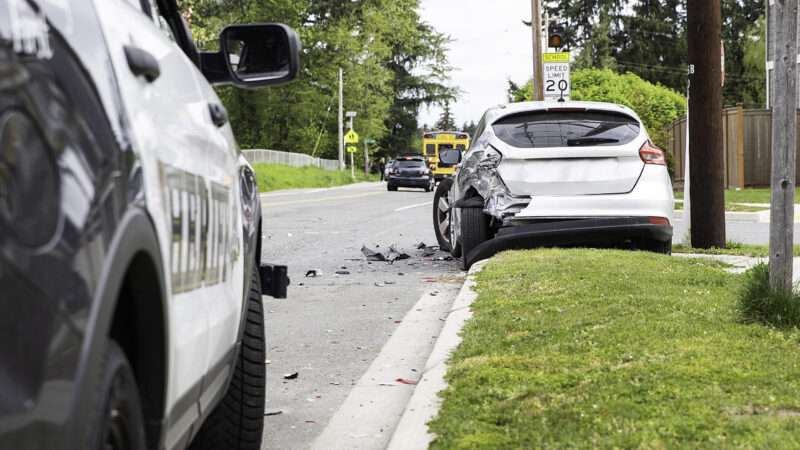
In the 1980s and '90s, a push to lower the legal blood alcohol content (BAC) limit for getting behind the wheel took the country by storm. Mothers Against Drunk Driving (MADD) was formed in 1980, and in 2000, President Bill Clinton signed into law the nationwide .08 BAC limit—conditioning the provision of federal highway funds on state compliance with the new limit.
Drunk driving rates are far lower today than several decades ago—falling by around half since the early 1980s, according to the National Institutes of Health. Even so, controversy over the legal limit has found renewed life, with a campaign to push for even further reductions in the permissible BAC level for driving.
The World Health Organization's (WHO) 2024 global status report on alcohol and substance use disorders garnered attention for noting that most countries have moved to a .05 or lower BAC legal limit. Media outlets like The New York Times and National Geographic were quick to run articles about America's seemingly outlier status when it came to drinking and driving.
Advocates for the lower limit cite laboratory and simulator research that purports to demonstrate alcohol impairment setting in at lower BAC levels than .08 and which conclude that lowering the legal limit would therefore reduce crashes and deaths. A study drawing on international BAC levels concluded that reducing the U.S. BAC level to .05 would result in an 11 percent reduction in alcohol-related crashes.
Utah became the first state to reduce its BAC level to .05 in 2018, which makes it a critical case study of what would happen if more states followed suit. The WHO has pointed to a 2022 National Highway Traffic Safety Administration (NHTSA) study finding that Utah's law change had resulted in a dramatic and almost immediate 20 percent reduction in drunk driving deaths.
As expected, that isn't the whole story.
Despite being published in 2022, the NHTSA study only tracked one year of post-.05 data: Utah's 2019 drunk driving deaths (the .05 law was passed in 2018 and went into effect starting in 2019). From 2016-2018, there were an average of just over 33 drunk driving deaths per year in the Beehive State, including a particularly deadly 2018, which saw 48 deaths alone. In 2019, the first year of the .05 law, deaths plummeted to 27 and the law was heralded as a massive success.
Following that dramatic dip, however, drunk driving deaths in Utah bounced back to 48 in 2020. In 2021, there were 61 fatalities, and in 2022, there was a state record of 69 deaths.
And yet, two prominent New York Times articles from earlier this year on America's higher-than-average BAC level cited Utah's 20 percent reduction in drunk driving deaths in 2019, but said nothing whatsoever about Utah's drunk driving death data since then. The aforementioned National Geographic article, and even WHO's much-ballyhooed report, likewise did not acknowledge the existence of the post-2019 Utah data, despite 2024 publication dates.
Local Salt Lake Tribune columnist Robert Gehrke, on the other hand, is willing to state the truth:
In the four years since the law took effect, 187 people died in alcohol-related crashes, up about 20 percent from before the law passed, and the last three years have been the highest on record.
Obviously, I'm not suggesting the law is to blame. The drivers are. But the law hasn't worked because it isn't targeting the real problem—those who drink well beyond any legal limit and get behind the wheel.
Half of all drunk drivers who are involved in fatal car wrecks are extremely intoxicated—sitting at BAC levels of 0.15 or higher. In contrast, only 16 percent of those involved in fatal wrecks have BAC levels under 0.08 (and the number is even lower for those specifically in the .05 to .07 range who would presumably be impacted by a switch to a .05 legal limit).
The worst drunk driving perpetrators are also often repeat offenders who appear to be impervious to any legal limit. About 30 percent of DUI arrestees in Utah had a prior arrest for drunk driving and 10 percent had two or more arrests. This is the political reality that few want to address. The couple who has a couple of glasses of wine with dinner is not the problem—it's the person who is well over the legal limit and often a repeat offender who is causing the majority of carnage on American roads. In fact, even Candace Lightner, the founder of MADD is against the proposal, stating that "running around trying to arrest everyone at .05 is impractical."
Proponents of lowering the legal limit may still argue that even one life saved with a lower BAC level is worth whatever costs might be associated with more DUI arrests. Even if this line of logic is adopted, however, the penalties could at least be reduced for those in the .05–.07 range, or the infraction could be converted to a civil fine rather than criminal sanction.
No one wants to see more drunk driving deaths in America, but we won't decrease them by ignoring the data.
The post Will Cutting the BAC Limit to .05 Really Make Our Roads Safer? appeared first on Reason.com.







